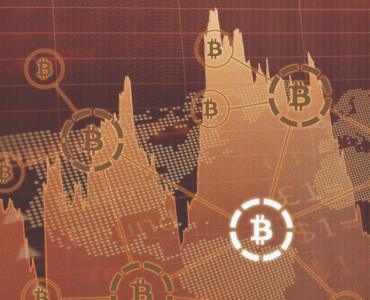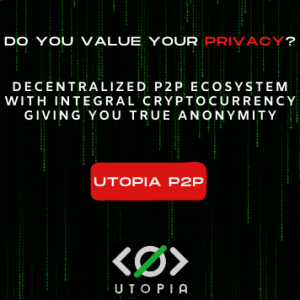If you live under a rock, you may not have heard about Utopia Ecosystem. For those Utopia was launched 2 years back, Utopia offers decentralized peer to peer ecosystem with integral cryptocurrency currency known as Crypton which is traded on public exchanges and on a dedicated integrally hosted exchange aswell. The 1984 Group, have developed a solution the global community has been in desperate need of for decades and it’s known as Utopia Ecosystem.
To begin, it is worth noting that Utopia is a third generation peer-to-peer (P2P) network, which means that all nodes connected to the network are equal. But the biggest question is how does Utopia ensures such level of user privacy and enables freedom from all sorts of censorships.
What is a Peer to Peer (P2P) Network
A peer-to-peer network is a completely decentralized system without any reliance on central servers. The main advantage of abandoning the client-server architecture is the ability to maintain performance with any arbitrarily large number of network participants. Any central server is a potential threat to security and reliability: servers are critical points of intersection between communication channels, and vulnerable to sudden breakdown or failures of equipment as a result of third party actions. The recent downtime of Facebook owned products is a great example of how centralized system are a reliability fiasco. Ultimately, all servers belong to real people and organizations which are vulnerable to external pressure. So, the 1984 Group, believe that complete rejection of centralized servers is the only possible solution for organizing a fully confidential and anonymous means of communication.
The initial process of searching for and connecting to other P2P network nodes is usually one of the most pronounced weaknesses in organizing a robust, censorship-resistant, distributed network. One common solution is the utilization of a central server. For example, when using the BitTorrent protocol, a node must connect to a tracker (the name of a special server that stores data about BitTorrent network peers) to obtain the addresses of other nodes. But central servers are always the weak link. The 1984 Group, solved the critical problem of primary node search using alternative, varied, and rather creative methods. Using the Utopia network node search cascade algorithm, users have a means of network access and confidential communication without susceptibility to censorship at any level.
Utopia Ecosystem Privacy Ensuring Techniques
Depending on a number of factors and a user’s unique circumstances (the type of network connection, provider blocking, the other peers’ presence on the local network, censorship in your region, and others), Utopia independently performs the necessary search for the initial peers in the following ways:
First of all, Utopia will make IP/DNS Resolve pre-defined IP addresses in the distribution and will try to obtain a list of available peers from them. If the IP address data is blocked by censorship, Utopia proceeds to the next step: the UDP local method. Specifically, the broadcast of requests to connect to the local subnet nodes. If this does not work, the Utopia client will scan the internet in search of pre-placed images in which the IP addresses of the initial peers are encrypted. No one will ever be able to prohibit posting pictures to the World Wide Web.
Utopia has also provided additional methods of connection. The Utopia client searches for Bitcoin transactions. The initial IP addresses of the peers are encoded in various transaction amounts. an approach used by another cryptocurrency — NXT. What has been described thus far is merely a partial list of the methods used by the software client for making an initial connection to the Utopia network. During frequent communication with the team it was revealed that Utopia has also inserted additional methods, the essence of which is kept a secret to avoid exploitation and better ensure the reliable operation of the peer-to-peer connection process in the Utopia network.
As users stay online and use Utopia ecosystem, it helps the network to function better and the client to be faster, more reliable, and more secure.
Utopia Ecosystem Network Encryption
Utopia code audit is still due which will further shed some light, uptil now we have information which has been shared by the team and 3rd party researchers who have tried to breakdown Utopia to find out what it is made off. Uptil now what we know now is that a message is sealed with two layers of modern elliptic curve encryption before it is transmitted across the network. Encryption is implemented in authentication mode using the libsodium library using the public key encryption algorithm (Curve25519 + XSalsa20 stream cipher + Poly1305 MAC). Industry professionals can find useful information about the implementation of the encryption algorithm.
Utopia uses a modern, non-compromised encryption algorithm using an open-source cryptographic library. It is also worth mentioning that all our confidential data is encrypted using a key pair between the sender and the recipient (end-to-end encryption), but encryption is not limited to this. At any stage of message transmission between two nodes of the Utopia peer-to-peer network, your message is additionally encrypted by a second layer using the temporary private and public keys of the transmitting and receiving node. Already twice-encrypted data, which is a random set of bits, is additionally hidden from prying eyes at the stage of packaging in the TCP transport protocol. Here, the packets of transmitted information are camouflaged under popular and frequently used data transfer protocols. Because of this, it is impossible to detect Utopia traffic by your internet service provider. This means that no matter where an attacker is located, no matter what network segment is subjected to traffic analysis, the use of tables for identifying the passing traffic will not give any results. You will always remain securely protected from any tracking services and traffic monitoring organizations.
The following diagram clearly demonstrates the entire process of Utopia multi-level message encryption.
Utopia Ecosystem Routing Mechanism
1984 Group have developed an absolutely revolutionary routing algorithm based on the calculation of the optimal (the best at the time selected for sending a message) message delivery path.
While developing this algorithm, the team set out to achieve the following objectives:
- to remove such disadvantages of DHT routing as the database weights or the theoretical possibility of deanonymization.
- The algorithm also lacks the disadvantages of Broadcast and does not clog the communication channels with a huge network load.
To further explain how Utopia’s algorithm works using the following example of classic (snail) mail. To make a delivery, at the very least the address of the recipient of the letter must be provided on the envelope, but usually the sender’s address is also specified so that the letter can be returned if the recipient is not found at the provided address. Imagine that through the letter’s entire route of delivery, each of the forwarding points (nodes in Utopia case) noted from which trans-shipment point this letter was delivered. Then a reply letter can only be sent using these nodes. Obviously, depending on the frequency and direction of sending letters, the readings of the nodes will change. This method eliminates the possibility of deanonymization of users. In addition, the 1984 Group has developed an additional anonymization mechanism — periodically, decoy TCP packets are sent with the purpose of misleading any technical means of analysis, thereby preventing any third parties from monitoring the network to identify the true sender or recipient of a message. One drawback of such implementation is higher use of data which can be lowered by selecting “Low Data Mode” in Utopia although that lowers your protection.
The routing algorithm developed narrows the address space of network nodes from 256 bits to 128 bits. This means that both the sender and the receiver are hidden from any prying eyes among 2128 (slightly more than 1038) other nodes of the Utopia network that have the same address. This way, it will not be possible to determine the identity of the communicating parties.
For a better understanding of the method, an example from nature might be useful. The volume of water in the world’s oceans is estimated at about one and a half billion cubic kilometers. The volume of one drop can be estimated at about 0.05 milliliters. As a result, all the water on the planet Earth is less than 10²⁶ drops. From that, we can conclude that using Utopia’s irreversible address narrowing, both the sender and the receiver are obscured behind the other nodes of the Utopia network much better than a drop of water hides in all the oceans of the world.
It is worth reconsidering the idea of scoring routing when forwarding messages. Each intermediate (transit) node of the network for each element of the set of open network connections carries out the process of accumulating statistics of messages passing through it. The accumulation occurs at the senders’ addresses (in the set of 128 bits) as nodes that are guaranteed to perform network activity. Then, based on these statistics, the node decides whether this network connection is suitable for transmitting the message along the final path. The evaluation is based on a comparison of how often and successfully the communication channel was used to send or transmit data between nodes.
Each time a message is forwarded, one of the gears of the complex mechanism rotates, providing the next encrypted message directions for better delivery. The optimal direction can be found for each moment of time based on the transfer data made by other nodes. At the next point in time, the route changes slightly from the previous one for better anonymization of network users.
All nodes of the network are cogs of a large mechanism serving one goal: preserving the operation of the network and, at the same time, promoting the security and anonymity of users.
Utopia Ecosystem vs Tor Network
A comparison with the Tor network might quite naturally come to the reader’s mind. Rumours about its absolute security are greatly exaggerated, which has been proven by massive cases of deanonymization of the true owners of Tor resources. If there is no encryption when connecting to the input and output node, it is impossible to ensure sufficiently secure data transfer and user anonymity. The input node knows the real IP address of the user, and the outgoing node can accumulate all data except for this IP node. Regardless of the selected modes of operation, a large amount of data can become available to various people and organizations: your visits to various websites, your usernames and passwords, any personal confidential data and, finally, the real IP address of your location.
Also, the use of Tor is perfectly visible by any traffic analysis tool, therefore your internet provider knows when you are using Tor. This means that at the request of state agencies, the provider can hand over all records: who performed a specific activity, using what device and network address and at what time, and in particular, if the TOR network was used. I have talked touched risks of Tor in my Interview ” Utopia Ecosystem – Uses, Features and Future“. Do you still feel secure using Tor? Probably not.


Conclusion
Summarizing the description of the principles of operation, the fact that the Utopia network is a peer-to-peer decentralized self-regulating ecosystem. The Utopia network needs only users (nodes) to work forever. More users results in more robust and confidential network operation. All transmitted information within the network is sent exclusively in a double-encrypted form. Private messages are encrypted twice asymmetrically, while channel messages are encrypted asymmetrically and symmetrically (this makes it possible to decrypt a message from any channel participant rather than a predefined user with a given key). Any device on the Utopia network works to anonymize the senders/recipients of messages and, of course, to help determine the optimal routing of the transmitted information. Thanks to the use of multiple layers of encryption, only the sender and recipient can know the content of the transmitted data. Even meta data is absent from the transmitted data, which makes it impossible to accumulate even indirect information about network clients. Anonymization of network nodes is performed by using temporary keys, which support the upper level of encryption, as well as hashing the addresses of the sender and recipient. Masking the transmitted network packets prevents your internet service provider from distinguishing between encrypted Utopia traffic and VOIP phone calls or online video.
The Utopia network provides complete freedom from any methods of control or censorship – check out Utopia from their official website : https://u.is. This article doesn’t highlight all the features offered by Utopia ecosystem rather the network and routing aspect only.





















[…] make Utopia resilient to censorship. I would request everyone who are listening to this to google Utopia Routing Mechanism and Network encryption , I am sure it will leave everyone impressed on the efforts went into ensuring how users of the […]
[…] Utopia resilient to censorship. I might request everybody who’re listening to this to google Utopia Routing Mechanism and Network encryption , I’m positive it can go away everybody impressed on the efforts went into making certain how […]
[…] The DPI safety system was improved. Such a system is utilized by web service suppliers to additional limit entry to sure websites and purposes. One other important replace is the advance of the packet forwarding system. This has considerably affected the smoother loading of internet sites and pages on the internet. So, the community has change into a lot sooner and safer. Whereas Utopia continues to be trade main in its User Privacy. […]